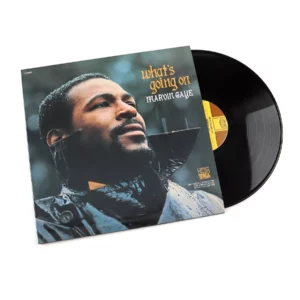Understanding the Musical Layers of Marvin Gaye’s “What’s Going On
By Manu Hasan
Hello everyone! I hope you’re all doing well. Recently, I’ve been spending time analysing Marvin Gaye’s iconic album “What’s Going On”, and I wanted to share some insights from our latest music seminar.
Marvin Gaye’s masterpiece is more than just a collection of songs; it’s a cohesive work that addresses social issues through intricate musical compositions. In our session, we focused on the recurring musical themes and motifs that tie the album together, and how these elements contribute to its lasting impact.

The 1-6-2-5 Chord Progression: The Harmonic Foundation
A key element that appears throughout the album is the 1-6-2-5 chord progression. In the key of E flat major, this progression includes:
- E♭ Major (I)
- C Minor (vi)
- F Minor (ii)
- B♭7 (V7)
This sequence creates a sense of movement and resolution, and Marvin Gaye uses it in various ways across multiple tracks. It helps to establish a familiar harmonic foundation that listeners can connect with.
Where It Appears
In “What’s Going On”, this progression forms the backbone of the song, providing a smooth and reflective atmosphere. The progression reappears in “Mercy Mercy Me (The Ecology)”, though with slight variations, showcasing Marvin’s creativity in reusing harmonic structures.
The Richness of Minor 9th Chords
Another significant feature in the album is the use of minor 9th chords, which add depth and complexity to the music. For example, the A minor 9th chord plays an important role in setting the tone for certain songs.
How It Enhances the Music
A minor 9th chord extends a standard minor chord by adding the ninth degree, resulting in a richer sound. This chord brings a “spacey” or open quality to the harmony, contributing to the emotional depth of the music.
Examples in the Album
In “What’s Happening Brother”, the song opens with an A minor 9th chord, immediately creating a reflective mood. This chord becomes a motif, appearing in different contexts throughout the album, helping to tie the songs together.
Suspended Chords: Creating Tension and Release
Marvin Gaye also makes use of suspended chords, especially sus4 chords, to add tension that resolves within the songs.
The Role of Suspended Chords
A sus4 chord replaces the third with the fourth, creating a sense of suspension that seeks resolution. This technique keeps the listener engaged, as it introduces harmonic tension that is eventually resolved.
Application in the Album
In “God Is Love”, the B♭7 sus4 chord adds a gospel-like feel to the music, enhancing the song’s spiritual message. Suspended chords are also used in “Mercy Mercy Me” to evoke feelings of yearning and hope.
The Descending Thirds Motif: A Melodic Connection
Melodic motifs are crucial in unifying an album, and Marvin Gaye uses a descending thirds motif across various tracks.
Understanding the Motif
This motif involves a sequence of notes descending by intervals of a third. It’s a simple yet effective way to create a melodic connection between songs.
Instances in the Album
In “What’s Going On”, the saxophone introduces a variation of this motif, setting a contemplative tone. The motif becomes more pronounced in “Mercy Mercy Me”, reinforcing themes from earlier tracks.
Thematic and Harmonic Unity
One of the remarkable aspects of “What’s Going On” is how Marvin Gaye creates a cohesive narrative, both musically and lyrically.
- Recurring Progressions and Motifs: The repeated use of the 1-6-2-5 progression, minor 9th chords, suspended chords, and melodic motifs ties the songs together.
- Narrative Flow: The album addresses themes of confusion, hope, environmental concerns, and social issues, creating a journey for the listener.
- Musical Continuity: Smooth transitions between songs make the album feel like a continuous piece, enhancing the overall impact.
Analyzing Key Tracks
Let’s look more closely at some of the songs to see how these musical elements come together.
“What’s Going On”
Theme: Social unrest and a call for understanding.
Musical Elements:
- Chord Progression: Uses the 1-6-2-5 progression in E♭ major.
- Minor 9th Chords: Introduced in the bridge, adding emotional depth.
- Melodic Motifs: The descending thirds motif appears subtly.
- Rhythm: A laid-back groove supports the reflective lyrics.
“Mercy Mercy Me (The Ecology)”
Theme: Environmental concerns and the impact of human actions.
Musical Elements:
- Chord Progression: Continues with the 1-6-2-5 progression, incorporating suspended chords.
- Descending Thirds Motif: Becomes a central melodic theme.
- Key Modulation: Shifts in key add to the song’s emotional intensity.
“Inner City Blues (Make Me Wanna Holler)”
Theme: Economic hardship and systemic injustice.
Musical Elements:
- Chord Progression: Moves away from the 1-6-2-5 progression, using more minor chords to reflect the somber theme.
- Rhythm: Incorporates syncopated rhythms and a strong bassline.
- Motifs: Revisits themes from earlier tracks in new harmonic contexts.
Conclusion
Marvin Gaye’s “What’s Going On” is a masterful blend of music and message. By understanding the harmonic structures and motifs he employs, we can appreciate how he creates a unified and impactful album. The use of recurring chord progressions, minor 9th chords, suspended chords, and melodic motifs all contribute to the album’s timeless quality.
Interested in Learning More?
If you’re inspired by the musical richness of “What’s Going On” and want to explore these concepts further, I’m offering piano lessons tailored to this style of music. Whether you’re just starting out or looking to deepen your understanding, we can create a study program that’s right for you.
Feel free to reach out if you’re interested or have any questions. Let’s make music together!
Manu Hasan
“`
